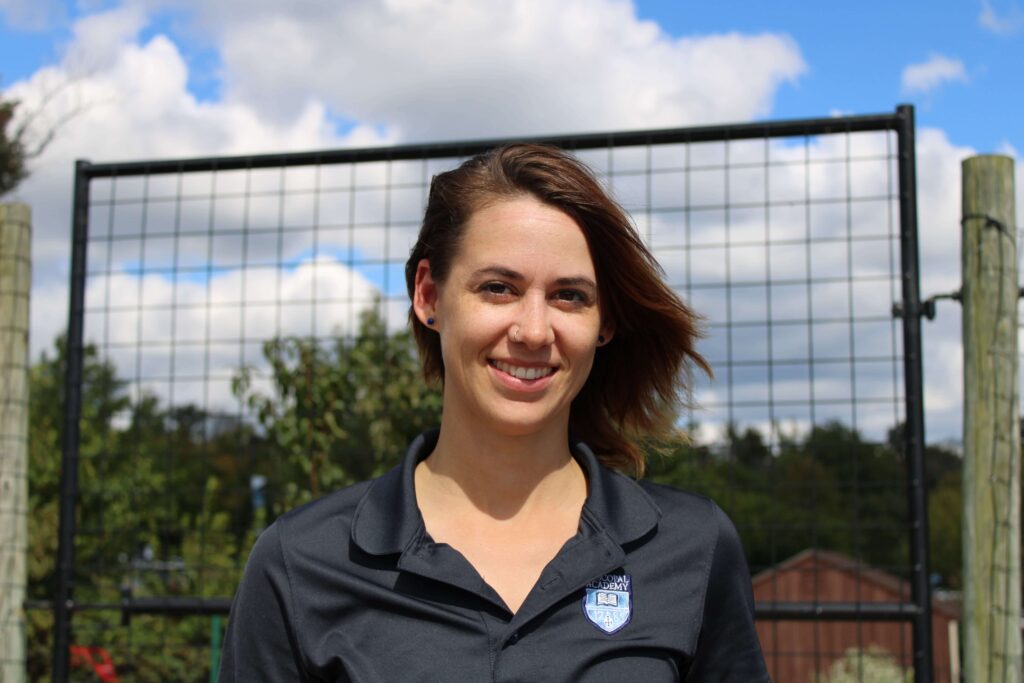Jack Crowley ’24 | Rohith Tsundupalli ’24
This year, EA hired Emily Mox to become the school’s first ever horticulturist. Mox has worked at several environmental institutions in the local community, from Longwood Gardens to Temple University, which have provided her with extensive expertise in gardening and soil health. Mox explains that “after completing the Professional Horticulture Program at Longwood Gardens, which equipped [her] with a wealth of knowledge and experience, [she] worked in various branches of horticulture from farmer to florist.”

Photo courtesy of Gianna Trala ’23
When Mox started her new role at EA over the past summer, she primarily focused on maintaining the new plants as well as fixing soil issues alongside EA’s grounds crew. Now, Mox has begun a long term project to revive the campus gardens, which are currently 15-years old and need to be replaced. She explains that “most gardens need an overhaul at the 15-20 year mark. I definitely have a long list of projects to rejuvenate all the spaces that are starting to look a bit tired.”
While Mox enjoys creating and maintaining gardens, she loves even more how her new role allows her to create a link between gardens and education. She hopes that her new role will connect people and plants wherever she is. She says, “At the moment, I am mainly creating the garden spaces, but long term I would like to incorporate more direct teaching into my job.”
In addition to Mox’s new role, EA hosts many environmental initiatives. Jennifer Murphy, Middle School French teacher, currently hosts a farming elective in the Middle School, where she collaborates with students in the garden. She feels that farming at EA is especially important because “people need to have a sense of where their food comes from. [The EA community] is privileged to be fed well, but very few students know how the food that Sage provides arrives to EA or what veggies even look like in their unprepared form.”
Students have also played a role in EA’s environmental impact. Max Scharpf ’23 reseached how EA can use their gardening facilities most effectively to assist other local nonprofits, community gardens, and local farms. In March, Scharpf gained permission from the school to use sections of EA’s greenhouse to grow over 1,000 tomato seedlings, a highly demanded crop. He has already donated hundreds of seedlings to help nonprofits and community gardens avoid the burden of buying expensive tomato plants, and he even had a surplus which he returned to EA.

Photo courtesy of Max Scharpf ’23
Although Scharpf thinks that EA does a sufficient job at educating its students about environmental issues, he believes that “the general student body is insufficiently encouraged to participate in their countermeasures [taking action to combat environmental issues].” He goes on to state that “there is little-to-no incentive for students to inconvenience themselves in order to marginally combat big-picture problems such as climate change, habitat destruction, and resource depletion.”
In addition to Scharpf’s project, the Student Alliance for Sustainability club led by Riley Thibodeau ’23 and Maggie Lo ’23 is yet another environmental movement taking place at EA. Thibodeau explains that the club “hopes to work with the school and our wider community to improve our environmental impact. The Student Alliance for Sustainability has planted trees, and is looking to work with the cafeteria and gardens in order to increase sustainability.” Another student environmentalist at EA, Ashley Kim ’23, created a Lilley Fellowship project focusing on sustainability in the fashion industry. She is “optimistic about the number of students excited and willing to engage in conversation about sustainability on campus and beyond.” She feels that awareness around environmental sustainability is rising as there have been “a number of Lilley Fellowships that have centered around sustainability. It is evident just how many paths environmentalism can take students and prepare them to be passionate, informed, activists for the future.”
The numerous environmental initiatives at EA, including the hiring of Mox, has made Scharpf optimistic about EA’s future with environmental sustainability. He explains, “The future is bright for EA’s sustainability initiatives, and I look forward to seeing more student involvement in the fight against environmental degradation.”